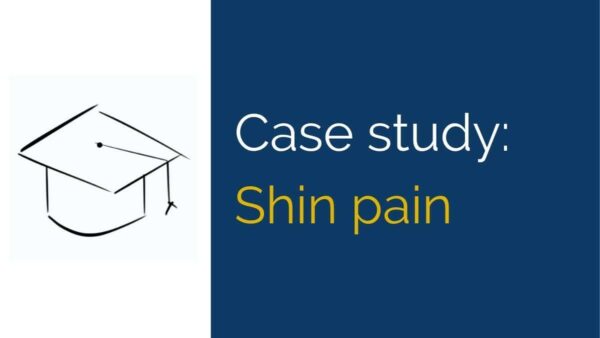Background – Shin pain
This shin pain case study examines diagnostic reasoning including imaging options, interpreting functional tests and causative biomechanics for running injuries.
Minimum Level
Physiotherapist with 2+ years experience
History
Amanda is an active 38 year old who runs 2-3 times per week, typically around 5-8km per run.
Discuss the relevance of a running volume of 10-24km each week.
Mentor’s reasoning:
She has been involved in a variety of team sports throughout her life but has only taken up running in the last two years.
How might this information impact your reasoning on causative biomechanics?
Mentor’s reasoning:
Amanda started to notice a mild shin pain on her Left side around 6 weeks ago.
The shin pain initially came on towards the end of a run but over time, starts to become symptomatic earlier in the run. It now comes on within 5 minutes of starting running and worsens as the run continues.
Amanda now stops her runs at 3km due to pain as the primary limiting factor.
Discuss this pattern of shin pain compared to other common shin pain pathologies.
Mentor’s reasoning:
The shin pain gradually eases after running but is now taking up to 24 hours to resolve.
Is this information relevant to your diagnostic reasoning?
Mentor’s reasoning:
There’s mild pain on initial weight-bearing the morning after running but it passes within a few steps.
What might account for this observation?
Mentor’s reasoning:
There were no specific changes to training volume or running shoes associated with the onset of symptoms.
Amanda did start to run with a friend for most of her runs a few weeks before symptoms started. The friend is able to run up to 8km but runs at a much slower pace than Amanda’s normal runs.
Explain the changes in running biomechanics and loading from running at a slower-than-comfortable pace.
Mentor’s reasoning:
Amanda has no history of shin issues.
How might this impact your reasoning?
Mentor’s reasoning:
Do you have any follow up questions on past history?
Mentor’s reasoning:
Amanda’s massage therapist noticed increased soreness and tightness around the Left hip in the last 8 weeks.
Does this seem relevant in Amanda’s case?
How would this information affect your reasoning on causative biomechanics?
Mentor’s reasoning:
Physical Examination
Amanda’s last run was 3km yesterday morning. She has no symptoms at rest or with walking today.
How might this impact your physical examination?
Mentor’s reasoning:
On Left leg single leg stance (Trendelenburg’s Sign), Amanda’s non-stance hip drops slightly and she reports no symptoms.
What is the relevance of Trendelenburg’s Sign in this case?
Mentor’s reasoning:
During Left single leg squat, there is no pain but Amanda notes that her ankle stops her going any lower than a 1/4 depth. We observe that the Right foot moves behind the Left leg during the lowering phase of the squat after a few reps.
Explain how you would interpret this finding and how it impacts your reasoning on causative biomechanics.
Mentor’s reasoning:
Hopping on the Left leg generates the shin pain and is associated with poor stability, with a distinct pelvic drop observed.
Explain how you would interpret this finding and how it impacts your diagnostic reasoning.
Mentor’s reasoning:
Palpation on the medial border of the Left tibia is painful on a localised 1cm region in the distal 1/3 of the bone.
Discuss the typical palpation findings for common shin pain diagnoses.
Mentor’s reasoning:
Active dorsiflexion generates some mild shin pain in the same region as the presenting symptoms.
What might cause Amanda’s shin pain on this test?
Mentor’s reasoning:
Dorsiflexion is limited to 4cm on knee to wall testing, compared to 9cm on the Right.
Provide a step-by-step explanation of how this can load the symptomatic area, as if you were explaining it to a patient.
Mentor’s reasoning:
Hamstrings range on 90/90 testing is restricted to 50 degrees bilaterally.
Discuss the relevance of this finding with regards to the provisional diagnosis.
Mentor’s reasoning:
Max calf circumference is 32.5cm on Left and 34cm on Right.
Discuss the implications of this difference on potential causative biomechanics.
Mentor’s reasoning:
Diagnosis
What is your provisional diagnosis?
Which features of the case have you based this diagnosis on?
Mentor’s reasoning:
What are your differential diagnosis/es?
Which features of the case have you based that on?
Imaging
Do you think that imaging is required at this stage?
If you will utilise imaging, which forms of imaging would you request and why?
Causative biomechanics
Explain your theory on the biomechanical loading that has lead to this injury.
Management planning
Justify your top 3 management strategies based on information in the history or physical examination.
What are your benchmarks to monitor progress?
What is your goal for this benchmark to progress to the next phase of rehab?
Like to continue the conversation? Head over to our Facebook page.

